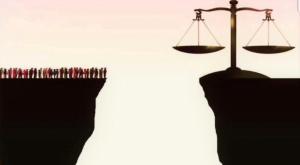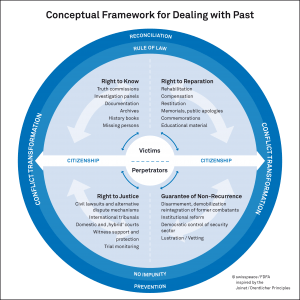Op:ED: Dealing with past human rights abuses in Ethiopia: Building the bridge between justice and peace
“Let us stand together to say: Never again shall a few people oppress us as a nation. Never again shall the beautiful smiling Coast experience a tyranny of the minority against the majority,” President Adama Barrow on Launching Truth and Reconciliation Commission of Gambia on October 15, 2018
Nega Gerbaba Toles, For Addis Standard
Addis Abeba, December 12/2018 – “Never, Ever again!” reads one message under a statute of grieving mothers at the entrance of “Red Terror” Martyrs’ Memorial Museum in Addis Abeba, Ethiopia. The museum was built to remember a generation who were killed because of their political views and affiliations in the 1960s and 1970s in Ethiopia. In the museum there are several collections of items in display includes victim’s clothes, publications, long list of victims’ photos and names, and most disturbingly, skulls and bones collected from mass graves, photos of corpses, graphic representation and depictions of prisons and underground torture places. On the other side of the museum there is a list of convicted criminals and their sentences. The tour in the museum is one of the moments in life where one stops, thinks and reflects on what exactly happened in the past in Ethiopia and on which side of history one is remembered. But there is also a question one is hardly able to escape after a visit to this museum: what, if anything, have we, as a country, ever learnt from our past experience?
When it comes to the issues of respect for basic human rights, the last 27 years of EPRDF’s leadership in Ethiopia’s politics are known for security crackdowns on civilians, post-election violence, weak civil society, weak, unfair and biased justice system and other forms of massive human rights abuses that have resulted in crimes against humanity. Of interest here is not the fact that Ethiopia’s history is free of rights abuses, but the fact that the abuses in the past 27 years were orchestrated and executed by the same government which built the statute of “Red Terror” Martyrs’ Memorial Museum and wrote slogans such as “Never Ever Again!”
In what appears to be a sharp departure from the past, on November 13, 2018, Ethiopia’s Attorney general admitted that under the same government, massive human right abuses have happened in the country. These crimes are committed by the country’s military, security and intelligence establishments, intentionally causing serious physical and psychological sufferings to human beings, the AG further admitted. These are crimes that are included in Article 7 of the Rome Statute of the International Criminal Court, which defines what is considered as crimes against humanity.
Be that as it may, the press statement by the Attorney General only shades light on the crimes that have been committed for the last 27 years and reported by victims and human rights organizations on various occasions. So far, there were/are no proper investigations conducted or are being conducted to understand what exactly happened in the last 27 years; and save for the ongoing trials, there is no single person held accountable, prosecuted or convicted of these crimes. However, these are crimes which are creating a sense of injustice in the society. In the long run, if not addressed, such impunity will make people to fight back and make conflicts to develop into chaos.
The need to deal with past human rights violations
Massive human rights abuse and crimes against humanity creates a rift between societies and the government especially those who are in power at the time of the abuse. To move forward there is a need to deal with the past. Though there are different reasons for this, the importance of justice for the victims and reparation that follows are the main ones. It is also a method of reconciliation and a way to guarantee the non-recurrence of human rights abuses in the future.
There are four components and a lot of sub-components to say the past is dealt with according to a model developed by Swiss Peace: Right to know, right to reparation, right to justice and guarantee of non-recurrence. Though this model is not the only one, it uses holistic approach, which makes it one of the effective ways to deal with past.
At the core of this model and in any human rights abuse cases we find victims and perpetrators. It is better to see these components in brief by analyzing the situation in Ethiopia starting with the right to know by the victims and their families.
The right to know
The right to know is very broad and includes a lot of components. To fulfill the right to know establishing truth and reconciliation commissions is one. There are experiences of South African Truth and Reconciliation Commission, which dealt with Crimes Against Humanity that took place during the Apartheid era. The commission dealt with investigation of human rights abuse issues and recommending how to rehabilitate the victims and preserve evidence of past human rights abuses.
Documentation and creating archives for future reference and inclusion of what happened during massive human rights abuses in history books is another aspect of right to know. The sooner documentation works are done, the better; as time passes by the destruction and tampering of documents as well as getting the information will become very difficult. Searching for missing persons and cases of forced disappearance is another big work which will give closure for the families of the victims in the right to know category. In Ethiopia there are long established reports about secrete detention centers, which are confirmed by the Attorney General, in addition, the society in general and victims and their families in particular have the right to know what happened in the torture chambers like “Maekelawi”, jail Ogaden and other federal and regional prisons in the country.
At this time, when hope about the future of the country seems in the horizon, there are families who never knew the whereabouts of their loved ones who disappeared for the past 27 years, about which the government said nothing so far.
The right to justice
Where there is justice, there can be peace, and vice versa; the absence one will result in the absence of the other. Victims of human rights abuses have a desire for justice and peace and/or at least to end conditions that lead to human rights abuses. On the other hand there is a dilemma from the government’s side pursuing peace at the cost of justice. But the state has a responsibility to investigate the massive human rights violations and prosecute those who have been involved by following due process of law. Civil law suits for reparation and criminal prosecution for crimes committed are part of the right to justice. To this end, there are experiences gained from the trial and prosecution of officials of the Derg regime who have been involved in massive human rights abuses and crimes against humanity during the dark “Red terror” era.
In addition to civil and criminal lawsuits, it is also important to look at the traditional way of solving such issues in the country. Ethiopia has customary mediation and arbitration cultures such as “Jaarsumaa” and “Gumaa”, among the Oromo; “Shimglina” among the Amhara; “Yejoka”among the Gurage; and “xeer” among the Somali people. Every society has its own way of addressing issues of unlawful death and injury. Though those practices cannot be applied at national level and have limited reach and do not have ways to deal with massive human rights abuses, there is a possibility to institutionalize these traditional practices as an alternative. Gacaca courts in Rwanda were used as way of dealing with the past to bring justice to the community. These customary practices are also ways to mend the broken relationships between the society as well as the society and the government. The right to justice have to take into consideration that there must be no-impunity for the perpetrators and have to deter others from committing similar crimes against humanity.
The right to reparation
The right to reparation is not only about compensation in monetary aspect for physical or mental injury, lost opportunities, physical damage and defamation. It is also about rehabilitation of victims, commemorations, public apologies and production of educational materials about what happened in the past. Restitution of victims to their previous situations is part of the right to reparation. Reparations are not only responding to basic needs of the victims but also about acknowledging what happened in the past. As a symbolic and material aspect is included, it is about making sure the reparations are legitimate and just. Peru, Chile and Argentina are countries that included pecuniary reparations for the victims.
Guarantees of non-recurrence
In Ethiopia, massive human rights abuses were conducted by the state police and security as well as military forces in the name of protecting the constitution by using repressive laws and extra judicial means. Though one of the components of guarantying non-recurrence is disarmament, demobilization, and reintegration of former combatants, it is difficult at this time to say how much crimes against humanity is committed by combatants as it is not comparable to the abuses by the government forces. The democratic control of security sector is a crucial issue to guarantee non-recurrence of massive human rights abuses and make accountable the security forces when human rights violation occur. Creating a system which have checks and balances between the legislative, executive and judicial branches of the government is a primary concern here. Officials who have been involved in past human rights abuses have to be vetted in order to prevent them from holding on to public offices.
It is true that there are efforts to reform the security and judiciary sectors in Ethiopia. It started with replacing officials who led these institutions. There are also positive steps to reform Ethiopia’s repressive laws such as the Anti-Terrorism Law, the Civil Societies and Charities Law and the Media Law. But replacing officials and reforming the laws is not enough. Besides, officials who have been involved in past human rights abuses still hold public offices. Ethiopia has come a long way in the past seven months, but there is a long way to go to make the security and police apparatus to serve professionally without political interference and not to be used as tool to repress the dissidents and opposition parties as well as suspected individuals by leveraging the state.
The process of dealing with past is not an overnight work. It may take years to start, process and need continues effort to ensure the respect for human rights. It is also about keeping the pace of reforms and rehabilitation for victims and their families. It is better to start the process immediately to give hope of justice for the victims, their families and society in general.
Evaluating the Ethiopian government on its process of dealing with the past
On June 18, 2018 the PM Abiy Ahmed has publicly acknowledged the existence of massive human rights abuses when he said that the government has terrorized its own citizens and admitted the practice of torture by the state security and police forces. He also asked for an apology. Last month, the Attorney General began a detaining and investigating suspects rights violations and massive corruption. This is one small step towards the whole process but it in no way represents the half of what it means to deal with the past. In addition, there is a tendency among some Ethiopians that the PM’s apology is enough as way of dealing with the past. This is wrong; dealing with the past involves a continuous process of learning from experience of other countries about transforming the society, supporting the victims, respecting the rule of law, ending impunity and preventing of further human rights abuses. A government that was at the heart of the problem cannot forgive itself. In South Africa after the Apartheid, the perpetrators and victims faced each other for confessions and the Truth and Reconciliation Commission had decided whether to give amnesty or not. Acknowledging the guilt and being accountable for the crime is only one part of the whole process. It is the whole process that decides on whether the past is dealt with or not. Based on this fact the Ethiopian government needs to start and do more to make sure that citizens feel safe in their own country and develop a belief in the government and the supreme law of the land, i.e: the constitution.
Despite the obvious arduous toll such processes will have, in the grand scheme of things, it is better if we face the inevitable now and close the chapter for good in order to move forward by negotiating on our common future. Unless the root cause of the problem is diagnosed and solved, we as a country will continue to build another museum saying “Never Ever Again!” and making the same mistake again and not learning from it.
Editor’s Note: Nega Gerbaba Tolesa studied Law and Peace and Security (MA) at AAU IPSS. He is currently finishing his LL.M on European and International Law at Saarland University, Germany. He can be reached at ngerbaba@gmail.com






